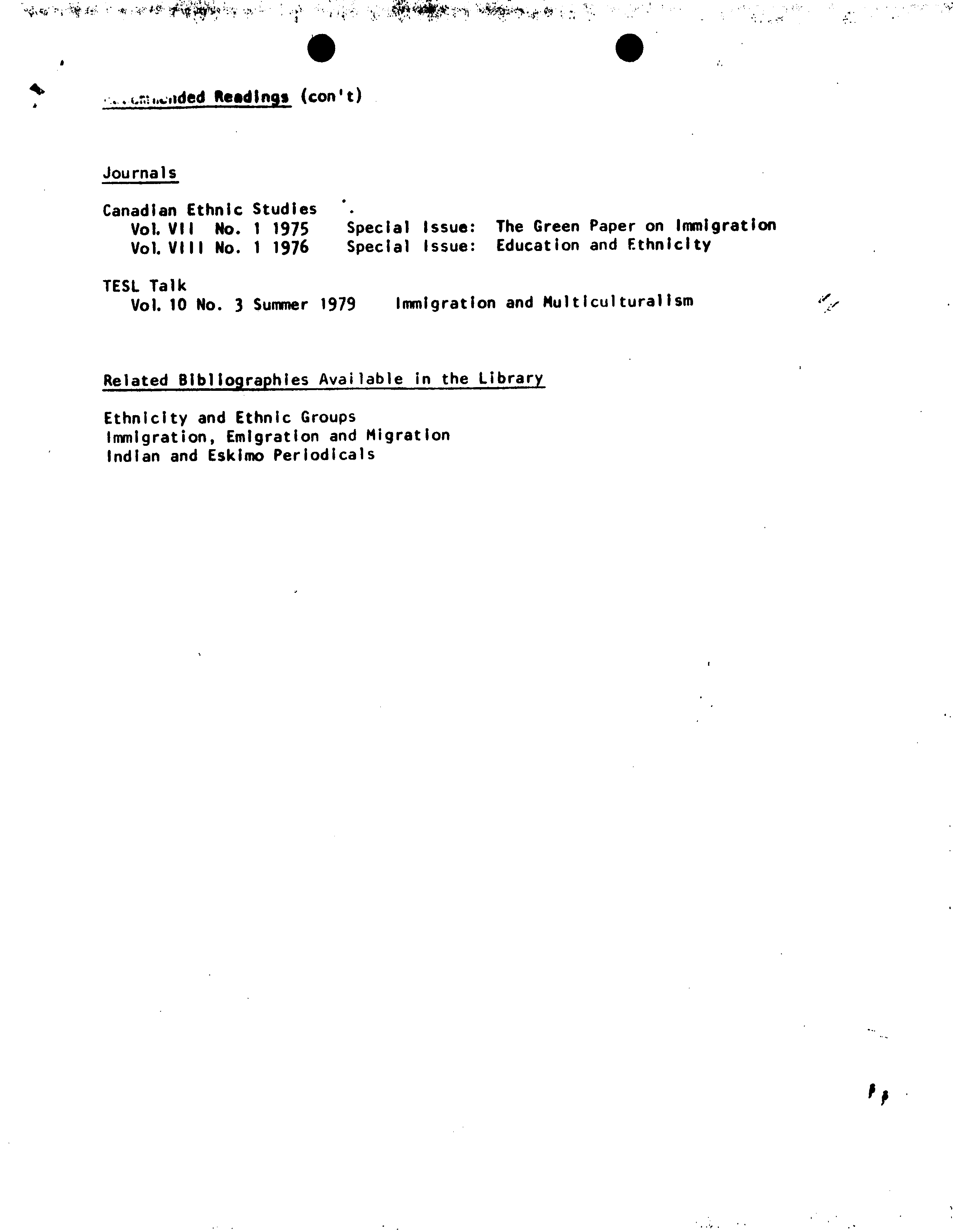EDUCATION 41-4
?
S ?
Cultural Differences and Education
Summer
Session 1979.
?
Richard 0. Dalbey
The course is designed as a seminar on the influence of
cultural factors in school learning, focusing on the dynamics of
majority-minority relations and their relevance for educational
policy and practice. The aim is to explore this arena in such a
way that we are better able tot (1) identify cultural characteristics
and differences, (2) appreciate and respect them, and
(3)
learn to
use them constructively in educational planning and school learning.
Preferring to accent depth rather than breadth, emphasis will
be placed on a modest number of major racial and ethnic groups
important to Canada and the United States. Although a cross-national
analysis comparing race and ethnic relations in a variety of
countries around the globe is no1 the intent of the course, students
will be asked to look at a particular aspect of minority education
in other cultures.
Special attention will be given to Canada and ethnic relations,
and the reality of multiculturalism and education in Quebec, Ontario,
and British Columbia as well as cultural, sociological, and historical
factors influencing the education of minority groups such as
Eskimos, Indians, Metis, Hutterites, recent immigrants, and the
developing subcultures of the inner city; and the prevailing ideology
in the United States with respect to cultural differences and the
role and policies of educational institutions in community, national,
and regional development to eliminate inequality. Emphasis will
also be given to recent trends and issuest class structure, ethnicity,
and regional variation as a basis for understanding social class
biases in education; schools and cultural assimilation; educational
aspirations as a new social force; and the social psychology of
heterogeneous schools.
During the course, students will be asked to concentrate on
creative projects in the subject area and to prepare a two-page
prospectus with annotated bibliographic entries. At the end of the
term, each student will in turn present his research findings to
the class in the form of an oral report.
From time to time, members of the community representing diverse
racial and ethnic groups will be invited to address the class.
TEXTS: Oscar Handlin, The Uprooted
Canadian Ethnic Studies. Special Issue: Ethnicity and
Education,
1976.
Toronto Board of Education, Final Report of the Work Group
gn Multicultural Programs,
1976.
Cole S. Brembeck and Walker H. Hill, Cultural Challenges
to Education,
1973
(optional but highly recommended for
further course work in the subject area).
"On Reserve" reading list and bibliography will be handed out first
day of class.
(
(
In the Library:
Curriculum
BANKS, J.
?
Teaching Ethnic Studies
BANKS & JOYCE
?
Teaching Social Studies to Culturally Different
Children
Teaching Language Arts to Culturally Different
Children
Alberta Elementary Social Studies Handbook: Experiences in Decision Making
RATHS, HARMIN, SIMON
?
Values and Teachi
SHAFTEL, FANNY AND GEORGE
?
Role Playing for Social Values
TABA, Hilda
?
Teaching Strategies for the Culturally
Disadvantaged
A Teachers' Handbook for Elementary Social
Studies
Curriculum Development: Theory and Practice
BOOKS (Ordered for the Bookstore)
ASHWORTH, Mary
?
Immigrant Children in Canadian Schools
CAZDEN, C.
?
Functions of Language in the Classroom
Teachers College Press
MARTELL, George
?
Politics of the Canadian Public School
General:
PALMER, Howard, Ed.
immigration and the Rise of
MultculturalISm
ROSENTHAL
Pygmalion ?
in the Classroom
RYAN, T.
Poverty and the Child:
?
A Canadian Study
HODGETTS
What Culture, What Heritage?
KRAUTER, Joseph
The Other Canadians:
?
Profiles
of Si* Minorities
MINGHI,;Julian
Peoplof the Living Land
?
(studies of ethnic
groups ?
in ?
B.C.)
LAMBERT, W.
?
E.
Bilingual ?
Education: ?
The St. ?
Lambert Experience
SWAIN, N.
Bilingual
?
Schooling: ?
Some
Experiences In
Canada and the U.S.
McLEOD, ?
N. ?
R.
Need Culture and Curriculum
Educatiff g ?
immigrants and Ethnic
Minorities
1969
Canadian Teachers Federation
?
The Poor at School
?
in Canada
1970
MOWAT, and St. Lawrence
New Canadian Activities:
?
Summary
of Teachers
Response to a Questionnaire,
?
1969
Ontario Association for
Curriculum Development
?
Conference
on Multi-
cultural ism In Education,
?
1977
COLES and HILL
Cultural Challenges to Education,
?
1973
p
7
*
a ?
. ? .
•.....,,ded Readings (cont)
Journals
Canadian Ethnic Studies
Vol. VII No. 1 1975
?
Special Issue: The Green Paper on immigration
Vol. VIII No. 1 1976
?
Special Issue: Education and Ethnicity
TESL Talk
Vol. 10 No. 3 Summer 1979
?
Immigration and Multiculturalism
Related Bibliographies Available in the Library
Ethnicity and Ethnic Groups
Immigration, Emigration and Migration
Indian and Eskimo Periodicals
Ashworth, Mary ougriant Children In Canadian
?
is.
Aoki, T. & Dahlie,
J.
whose Culture? Whose Heritag? UPC Faculty of DL
Cazden, C. Functions of Language In The
Classrccin. ?
aders Qllege Press.
Martell, George. Politics of
'the
Canadian Public
School.
cper &
PaJ.ner Issues
In Cultural Diversity, Ontario Institute For
Studies In
&txatioi, 1976.
%'blfgang , Aaron The F)iation Of linnigrant Students, OISE, 1976.
.
0




